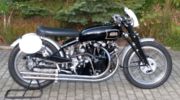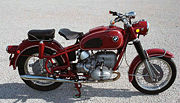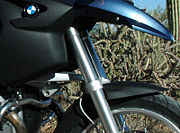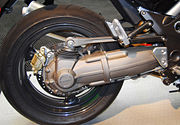Suspension (motorcycle)
From Wikipedia, the free encyclopedia
A motorcycle's suspension is similar to the suspension in an automobile in its purpose:
| “ | Suspension systems serve a dual purpose - contributing to the vehicle's handling and braking for good active safety and driving pleasure, and keeping vehicle passengers comfortable and reasonably well isolated from road noise, bumps and vibrations. — Suspension (vehicle) | ” |
But a motorcycle suspension is usually simpler, since it does not have to contend with lateral forces such as body roll. The typical motorcycle has a pair of fork tubes for the front suspension, and a single swingarm with one or two shock absorbers for the rear suspension.[1]
Contents[hide] |
[edit] Front suspension
The most common form of front suspension for a motorcycle is the telescopic fork. Early front suspension designs used frames with springs.
Some British manufacturers (eg Greeves) used a version of the swinging arm for front suspension on their motocross designs. A single-sided version of the idea was also used in motor scooters such as the Vespa
[edit] Telescopic forks
In 1934 Nimbus was the first manufacturer to produce a motorcycle with hydraulically damped telescopic forks. Most motorcycles today use telescopic forks for the front suspension. The forks can be most easily understood as simply large hydraulic shock absorbers with internal coil springs. They allow the front wheel to react to imperfections in the road while isolating the rest of the motorcycle from that motion.
The top of the forks are connect to the motorcycle's frame in a triple tree clamp (otherwise known to British riders as the top yoke and bottom yoke), which allows the forks to be turned in order to steer the motorcycle.
The bottom of the forks are connected to the front axle around which the front wheel turns.
On typical forks, the upper portion, known as the fork tubes, slide inside the fork bodies, which are the lower part of the forks. As the tubes slide in and out of the body they are telescoping, thus the term telescopic forks. The fork tubes must be smooth to seal the fork oil inside the fork, and typically have a mirrored finish, though some fork tubes, especially those on off-road motorcycles, are enclosed in plastic protective sleeves, known as gaiters.
"Upside-down" (USD) forks are installed inverted compared to typical forks, with the tubes at the bottom and the bodies at the top. This decreases the unsprung weight of the motorcycle and improves its handling. USD forks are usually found on sportbikes, though Honda's large power-cruiser, the Valkyrie, sported USD forks.
[edit] Pre-load adjustment
Motorcycle suspensions are designed so that the springs are always under compression, even when fully extended. Pre-load is used to adjust the initial position of the suspension with the weight of the motorcycle and rider acting on it. Both the front forks and the rear shock or shocks can be adjusted for pre-load on most modern motorcycles.
The difference between the fully extended length of the suspension and the length compressed by the weight of the motorcycle and rider is called "total sag". Total sag is set to optimize the initial position of the suspension to avoid "bottoming out" or "topping out" under normal riding conditions. "Bottoming out" occurs when the suspension is compressed to the point where it mechanically cannot compress any more. "Topping out" occurs when the suspension extends fully and cannot mechanically extend any more. Increasing pre-load increases the initial force on the spring thereby reducing total sag. Decreasing pre-load decreases initial the force in the spring thereby increasing total sag.
Since the weight of the motorcycle and rider are the only forces compressing the suspension from the fully extended position, preload doesn't change the forces on the springs under riding conditions. Changing the pre-load does not change the way the suspension reacts to bumps or dips in the road surface either. Two simple examples using the motorcycle's forks shows why:
- Suppose that the bike and rider put a total weight on the front suspension of 300 lb. Suppose the spring rate of each fork spring is 50 lb per inch. Installing a 1 inch long spacer in each fork leg gives a pre-load of 50 lb per spring, a total of 100 lb. When the weight of the rider and motorcycle are loaded onto the suspension it will compress 2 inch from full extension (2 inches total sag). Now the force exerted on (and by) each fork spring is 150 lb (1 inch pre-load + 2 inch total sag = 3 inch total spring compression) for a total of 300 lb, balancing the weight of the bike and rider.
- Suppose we now install a 2 inch long spacer in each fork leg. The pre-load is now 100 lb per spring, a total of 200 lb. The total sag will change since we still have the same 300 lb loading the forks. The total sag will now be 1 inch. The total force on each spring is the same as before, 150 lb on each fork spring for a total of 300 lb force. The front suspension's initial position is 1 inch longer than in the preceding example (1 inch less total sag).
Since the forces are the same in both examples the reaction of the suspension to bumps and dips in the road will be the same. The difference is that there is less chance of topping out in example 1, less chance of bottoming out in example 2. Motorcycle manufacturers generally provide optimal total sag settings.
This is also why too-soft springs cannot be "fixed" by adding pre-load, too-stiff springs cannot be "fixed" by reducing pre-load. Changing to springs of the correct spring constant for the total weight of the bike and rider is the only solution.
Some motorcycles have externally accessible pre-load adjustments. Typically, this is a screw-type adjustment that moves a backing plate inside the fork against the top of the fork spring. The farther down the adjuster is screwed, the higher the preload.
A few motorcycles allow adjustment of pre-load by changing the air pressure inside the forks. Valves at the top of the forks allow air to be added or released from the fork.[2] More air pressure gives more preload, and vice versa.
Pre-load on bikes without adjusters can be changed by disassembling the fork and changing the length of the spacer between the top of the fork spring and the fork cap. Spacers can be installed under the rear shock springs similarly. A longer spacer gives higher preload, and vice-versa.
The pre-load on both forks should always be the same. Dangerous handling characteristics and possible mechanical damage can result otherwise.[citation needed]
[edit] Damping adjustment
Some stock telescopic forks have external adjustments for damping. The adjuster is either a dial or a knob slotted for a screwdriver. Turning the adjuster turns a rod inside the fork which brings different sized orifices into alignment with the damping fluid flow path inside the fork. Smaller orifices restrict the flow of the fork oil more and give greater damping, and vice versa.
This adjustment is either for compression damping, rebound damping, or for both.
[edit] Fork oil
Since forks act as hydraulic shocks, changing the weight of the fork oil will change the damping. Higher weight fork oil will give more damping, and vice versa.
Fork oil collects impurities over time and should be changed periodically. A motorcycle's manual will give guidelines on how often the oil should be changed. Decades ago, it was often recommended to use ATF (automatic transmission fluid) as fork oil. Currently most sources recommend using an oil specifically designed to be used as fork oil.
[edit] Cartridge forks
Cartridge forks use internal cartridges with various leaf springs covering orifices to control the damping of the fork.
Some of the leaf springs lift with little force allow fluid to flow through the orifice. Other springs require greater force to lift and allow flow. This gives the fork progressive damping, allowing it to be stiff over small bumps, but get (relatively) softer over larger bumps.
Also, the springs only allow flow in one direction, so one set of springs controls compression damping, and another rebound damping. This allows the dampings to be set separately.
Cartridge emulators are aftermarket parts that make non-cartrdige forks behave like cartridge forks.
[edit] Gas-Charged Cartridge forks
In 2007 Traxxion Dynamics offered the first gas-charged bolt-in cartridge set for modern sportbike forks to the public. This kit is legal for "supersport" styled classes of racing, which regulations don't allow a complete fork replacement, and force competitors to use the stock fork casings. This was the first significant change in fork damping technology for road bikes since the introduction of the standard pumping style cartridge decades prior.
[edit] Brake Dive
Applying the brakes of a moving motorcycle transfers weight to the front wheel. For a detailed explanation, see the braking section of the Bicycle and motorcycle dynamics article.
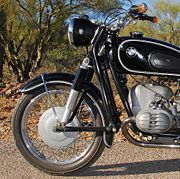
If the motorcycle is equipped with telescopic forks, the added weight to the front wheel is transmitted through the forks, which compress under the additional force. This shortening of the forks causes the front end of the bike to move lower, and this is called brake dive.
Brake dive can be disconcerting to the rider, who may feel like he or she is about to be thrown over the front the motorcycle. If the bike dives so far as to bottom out the front forks, it can also cause handling and braking problems. One of the purposes of a suspension is to help maintain contact between the tire and road. If the suspension has bottomed out, it is no longer moving as it should, and is no longer helping to maintain contact.
Brake dive with telescopic forks can be reduced by:
- Increasing the spring rate of the fork springs
- Increasing the compression damping of the forks
However, all of these changes make the motorcycle less pleasant to ride on rough roads, since the front end will feel stiffer, in the 1980s various manufacturers attempted to get round this by methods of anti-dive such as:
- ACT: Developed by Marzocchi and fitted to Buell motorcycles such as the Buell RR 1200 (1988).
- ANDF (Anti Nose Dive Forks): This was fitted to a number of Suzuki GSX models and the RG250.
- AVDS (Automatic Variable Damping System): This was fitted to a number of Kawasaki motorcycles.
- NEAS (New Electrically Activated Suspension): As fitted to the Suzuki GSX-R 1100 and GSX-R 750 Limited Edition.
- PDF (Posi Damp Fork): This was fitted to the Suzuki RG500 and GSX-R 750 and worked by brake fluid pressure closing a valve in the mechanism when the brakes are applied, restricting the flow of damping oil and slowing fork compression. The valves are spring loaded so if the wheel hits a bump when the brakes are on, they bounce off their seats and restore the flow of oil for a moment to allow the suspension to absorb the shock.
- TCS (Travel Control System): Anti-dive system with variable damping. TCS was introduced on the FZ 400 R (1984, only for the Japanese market).
- TRAC (Torque Reactive Anti-dive Control): This was fitted to a number of Honda motorcycles such as the early VFR750F and worked by utilising a pivoting caliper that activated a valve in the fork leg.
Another method to reduce or eliminate brake dive in telescopic forks is to use a reactive link or torque arm to connect the braking components to the motorcycle frame via the triple clamp.
Some fork designs mitigate dive, eliminate it, or even reverse it without affecting the front suspension adversely. The Earles fork is among the latter; when braking the front brake hard, the front end of the motorcycle actually rises. BMW's Telelever fork is designed nearly to eliminate dive, but could have been designed to eliminate it completely if the manufacturer chose to do so. Leading link front forks, such as used on some Ural motorcycles, can also be designed either to reduce or eliminate dive.
[edit] Saxon-Motodd (Telelever) fork
The Saxon-Motodd (marketed as Telelever by BMW) has an additional swingarm that mounts to the frame and supports the spring. This causes the trail and castor angle (rake) to increase during braking instead of decreasing as with traditional telescopic forks.
[edit] Hossack/Fior (Duolever) fork
The Hossack/Fior (marketed as Duolever by BMW) separates completely the suspension from steering forces. It was developed by Norman Hossack though used by Claude Fior and John Britten on racebikes. Hossack himself described the system as a 'steered upright'. In 2004 BMW announced the K1200S with a new front suspension that is based upon this design.
[edit] Single-sided
The only production motorcycle to use a single-sided front swingarm suspension was Yamaha's GTS1000, introduced in 1993. The GTS used the RADD front suspension designed by James Parker. However, a single sided girder fork was use by the German firm Imme between 1949 and 1951, and the Vespa scooter has a single-sided trailing-link fork.
[edit] Rear suspension

[edit] Early rear suspensions
While front suspensions were almost universally adopted before World War I, several manufacturers did not use rear suspension on their bikes until after World War II. However, motorcycles with rear suspension were offered to the public before World War I. Notable among these are the 1913 Indian Single with a swingarm suspended from a leaf spring and the 1913 Pope with wheels supported on a pair of plungers which were each suspended by a coil spring.[3][4]
[edit] Plunger suspension
Several motorcycles before and immediately after World War II used plunger suspension in which the vertical movement of the rear axle was controlled by plungers suspended by springs.[5]
Notable manufacturers of bikes with plunger suspension include Adler, Ariel, BMW, BSA, Indian, MZ, Norton, and Zündapp
[edit] Swingarms
The basic motorcycle swingarm is a rectangle, with one short side connected to the motorcycle's frame with bearings so that it can pivot.[6] The other short side is the rear axle around which the rear wheel turns. The long sides are connected to the motorcycle's frame or rear sub-frame with one or two shocks with coil-over springs.
In production motorcycles, swingarms are not exactly rectangular, but their function can be more easily understood by thinking of them as such.
Some swing arms have only one long-side, and are know as single-sided swingarms. Notable examples include the Honda VFR800 and the BMW R- and K-series of motorcycles. Single-sided swingarms make rear-wheel removal easier, though they generally increase the unsprung weight of the rear suspension. This is due to the additional material required to give identical rigidity to a conventional swingarm setup. For this reason sports bikes are rarely seen using the setup. Notable exclusions are the Ducati 916 which was intended to be taken endurance racing the MV Agusta f4 which has an innovative hollow interior for reducing weight(a magnesium version is also available)and a beautifully shaped line, and the Ducati 1098, which was given a single sided swingarm purely for styling reasons.
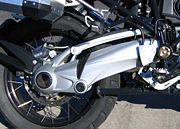
On many shaft-drive motorcycles the drive shaft is contained in one of the long sides of the swingarm. Notable examples include all post-1955 BMWs prior to BMW's use of the single-sided swingarms, Urals, many Moto Guzzi twins, the Honda Goldwing, the Yamaha XS Eleven, and the Yamaha FJR1300.
The BMW R- and K-series combine a shaft-drive contained in the swing arm with a single-sided swingarm, and the combination is marketed as the Paralever. Newer Moto Guzzi motorcycles use a similar arrangement marketed as the CA.R.C. ("CArdano Reattivo Compatto" - Compact Reactive Shaft Drive).
For motorcycles with chain drives, the rear axle can be adjusted forward and back in relation to the swingarm, to adjust chain tension.
[edit] Shock absorbers
The hydraulic shock absorbers used on the rear suspensions of motorcycles are essentially the same as those used in other vehicle applications. For more detail, see the article on shock absorbers.
Motorcycle shocks do differ slightly in that they nearly always use a coil-over spring. In other words, the spring for the rear suspension is a coil spring that is installed over, or around, the shock.
In terms of adjustment, rear shocks span the range from pre-load adjustments only to racing shocks with adjustments for pre-load, and four different kinds of damping. Most shocks have internal oil reservoirs, but some have external ones, and some offer air-assisted damping.
A number of companies offer custom-built rear shocks for motorcycles. These shocks are assembled for a specific motorcycle and rider combination, taking in to account the characteristics of the motorcycle, the weight of the rider, and the rider's preferred riding style/aggressiveness.
[edit] Twin shocks
Twinshock refers to motorcycles that have two shock absorbers. Generally, this term is used to denote a particular era of motorcycles, and is most frequently used when describing off-road motorcycles.
During the late 1970s and 1980s, motorcycle rear suspension design and performance underwent tremendous advances. The primary goal and result of these advances were increased rear wheel travel, as measured in the how far the rear wheel could move up and down. Before this period of intense focus on rear suspension performance, most off-road motorcycles had rear wheel travel of about 3.5–4 inch (9–10 cm). At the end of this period, most of these motorcycles had rear wheel travel of approximately 12 inch (30 cm). At the beginning of this period, various rear suspension designs were used to reach this degree of performance. However, by the end of this period, a design consisting of using only one shock absorber (instead of two) was universally accepted and used. Motorcycles with only one shock absorber are called monoshock motorcycles. The performance of monoshock motorcycles was vastly superior to twin shock motorcycles. Accordingly, this design distinction is readily used to categorize motorcycles. Since monoshock motorcycles have been the norm since the 1980s, the term "twinshock" is now used to categorize vintage motorcycles. This distinction is important in that it provides classes used for vintage motorcycle competition. For example, vintage motocross races are held for older motocross motorcycles. To prevent the better performing monoshock motorcycles from dominating the competition, there are separate competition classes for monoshock and twinshock motorcycles, which prevents them from competing directly against each other.
It is important on twin-shock motorcycles that both shocks be the same, and that if they are adjustable, that the adjustments on both sides be the same. Otherwise, there can be a torque to the swingarm which may cause dangerous handling and braking characteristics.
[edit] Mono-shocks
On a motorcycle with a mono-shock rear suspension, there is only one shock that connects the rear swingarm to the motorcycle's frame. Typically this lone shock is in front of the rear wheel, and uses a linkage to connect to the swingarm.
Mono-shocks eliminate torque to the swingarm and provide more consistent handling and braking. They are also easier to adjust, since there's only one shock to adjust, and there is no worry about matching two shocks. Also, the linkages used to connect the shock to the swing-arm are frequently designed to give a rising rate of damping for the rear.[7]
Honda refers to its mono-shock designs as Pro-link suspensions.
[edit] Pre-load adjustment
The pre-load on a rear shock is typically adjusted via a threaded or notched collar on the shock. As the collar is rotated, the coil-over spring is compressed more or less. The more the spring is compressed, the higher the pre-load, and vice versa.
Some shocks, known as air-assist shocks, allow adjustment of preload by changing the air pressure inside the shock. A valve on the shock allows air to be introduced or released from the shock. More air pressure gives more preload, and vice versa.
On motorcycles with twin shocks it is very important that both shocks have the same pre-load. Dangerous handling and braking characteristics can result from dissimilar pre-load adjustments.
[edit] Damping adjustment
Stock rear shocks typically offer no damping adjustment, or a single adjustment for both compression and rebound damping. This adjustment is usually made by a dial at the very top or very bottom of the shock. The dial selects one of a few different orifice sizes for the damping fluid flow path. The larger the orifice, the less the damping, and vice versa.
On motorcycles with two rear shocks, it is very important that the damping on both shocks be set the same. Dangerous handling and braking characteristics can result from dissimilar damping on the rear shocks.
[edit] Setting up a suspension
Many older motorcycles do not offer much in the way of suspension adjustments. Simple pre-load adjustment for the rear shock(s) and nothing more is not uncommon.
However, on modern motorcycles with higher specifications both pre-load and compression adjustments are standard, on both front and rear suspension. Some models as of 2006 offer both high and low speed compression adjustment.
Even those motorcycles that do offer adjustments sometimes cannot be adjusted far enough for some riders.
Properly tuning motorcycle suspension often requires assistance from an expert due to the range of adjustment possible. It is very difficult for the average rider to determine what adjustments need to be made, as a poorly set up rear end may cause front-end problems, and vice versa.
[edit] Travel
The total travel of a suspension is the distance the suspension travels between total compression and total extension. The travel distance on off-road and dual purpose bikes tends to be very high; the rear suspension travel on cruisers tends to be relatively little. This value is usually listed in the motorcycle's manual, or available on-line.
Adjusting the suspension based on the travel is the easist place to start tuning a suspension for a given rider. Ideally, the suspension should sag under the weight of the rider by 30 percent of the total travel.
Start by measuring a distance between two points along the suspension's travel with the bike upright but without any of the rider's weight on the bike. For example, measure the distance from the front axle to where the fork enters the bottom of the triple tree. On the rear, measure from the rear axle to a point on the frame directly above it.
Next, the rider should put as much of his or her weight on the bike while holding it upright. Measure between the same two points, and find the difference in the two measurements. This should be approximately 30 percent of the total travel of the suspension.
Increase the preload to reduce the sag; decrease the pre-load to increase the sag.
[edit] Spring rate
A spring's rate is a measure of how much force is require to compress the spring a given distance. The higher the rate, the more force it takes to compress it a given distance, and the less it compresses under a given force.[8]
If the sag of a motorcycle's suspension for a given rider cannot be properly set using pre-load adjustments, typically the spring must be replaced with one of a different rate. If the sag is too great, a higher rate spring must be used, and vice-versa. Even when the sag is set correctly sometimes the springs have to be replaced. This is dependent on the weight of the rider. If the rider is too light for the design of the springs the ride will be harsh, even when sag is correct. If the rider is too heavy the ride may be mushy, brake dive may be excessive, etc.
In most telescopic forks, the springs can be replaced in a straight-forward manner. The coil-over springs on the rear shocks can be another matter. Not only can they be of a unique design but the shock itself may be incompatible with a different rate spring if it lacks sufficient damping adjustment.
Progressive-rate springs are springs whose rate changes as the spring is compressed. As the spring is compressed the rate increases. Springs can be progressive either by having the coils at one end of the spring wound differently than the other, or by actually being two separate springs with different rates held together by a spacer.[9] For most modern sports bikes, progressive rate springs are not recommended unless factory fitted as the suspension linkage will usually have a progressive action. Fitting a progressive spring to such a linkage would cause the suspension to be too soft at one end of the linkage's movement and too hard at the other.
Progressive rate springs are intended to give the best of both worlds: a smooth ride, yet response handling over rough surfaces. For maximum suspension performance, however, straight-rate springs are usually recommended.
[edit] Damping
Damping prevents the springs in the motorcycle's suspension from oscillating, and the motorcycle from bouncing down the road like a bobblehead doll.
When, for example, the front wheel encounters a convex bump in the road, the suspension should compress when going up the bump, and extend when going down the bump, maintaining contact with the road at all times. Then the suspension should stop moving. Without proper damping, the suspension may continue compressing after the top of the bump has been reached, causing the tire to jump off the road. Or, it may continue to extend and compress after the bump, causing the front end of the motorcycle to bounce.
Compression damping affects the compression of the suspension, and rebound damping affects the extension of the suspension. In the convex bump example, compression damping affects the suspension's behavior traveling up the bump, and rebound damping affects its behavior down the bump.
Most stock suspensions do not offer separate rebound and compression damping.
The handling of a motorcycle with too little damping will feel soft and bouncy. The handling of a motorcycle with too much damping will feel stiff and jittery.
The proper damping will vary with the rider, the rider's style of riding and the road conditions.
To tune the damping for street riding, it is usually easiest to start with the damping too soft, then adjust the damping progressively stiffer until the motorcycle's handling no longer feels soft and bouncy.
High-end racing shocks offer low-speed compression damping, high-speed compression damping, low-speed rebound damping and high-speed rebound damping. The terms “low-speed” and “high-speed” are somewhat confusing as they do not refer to the speed of the motorcycle. Rather, the terms refer to the speed at which the shock absorber shaft is moving. Low-speed damping adjustments are used to ensure the bike is stable over gentle undulations in the road surface. High-speed damping deals with sharper variations in road surfaces and when the bike transitions from heavy acceleration to heavy braking or vice versa. The nuances of properly adjusting all these settings is beyond the scope of this article.
[edit] See also
- Bicycle suspension
- Fork tube
- Hub-center steering
- Motorcycle
- Motorcycle fork
- Shock absorber
- Suspension (vehicle)
- Swingarm
- Triple tree
- Öhlins
[edit] References
- ^ Motorcycle Mechanics Institute,The Complete Guide to Motorcycle Mechanics, 1984, p. 277, Prentice-Hall, Inc., ISBN 0-13-160549-6
- ^ Motorcycle Mechanics Institute,The Complete Guide to Motorcycle Mechanics, 1984, p. 291, Prentice-Hall, Inc., ISBN 0-13-160549-6
- ^ Wilson, H. "The Encyclopedia of the Motorcycle" p. 102 Dorling-Kindersley Limited, 1995 ISBN 0 7513 0206 6
- ^ Wilson, H. "The Encyclopedia of the Motorcycle" p. 156 Dorling-Kindersley Limited, 1995 ISBN 0 7513 0206 6
- ^ Wilson, H. "The Encyclopedia of the Motorcycle" p. 310 Dorling-Kindersley Limited, 1995 ISBN 0 7513 0206 6
- ^ Motorcycle Mechanics Institute,The Complete Guide to Motorcycle Mechanics, 1984, p. 282, Prentice-Hall, Inc., ISBN 0-13-160549-6
- ^ Motorcycle Mechanics Institute,The Complete Guide to Motorcycle Mechanics, 1984, p. 286, Prentice-Hall, Inc., ISBN 0-13-160549-6
- ^ Motorcycle Mechanics Institute,The Complete Guide to Motorcycle Mechanics, 1984, p. 279, Prentice-Hall, Inc., ISBN 0-13-160549-6
- ^ Motorcycle Mechanics Institute,The Complete Guide to Motorcycle Mechanics, 1984, p. 279-280, Prentice-Hall, Inc., ISBN 0-13-160549-6
[edit] External links
- Sport Rider magazine has a guide for sportbike suspension tuning
- Suspension Tuning tips by "Jacques Strappe"
- Suspension Set Up guide from former race team owner
